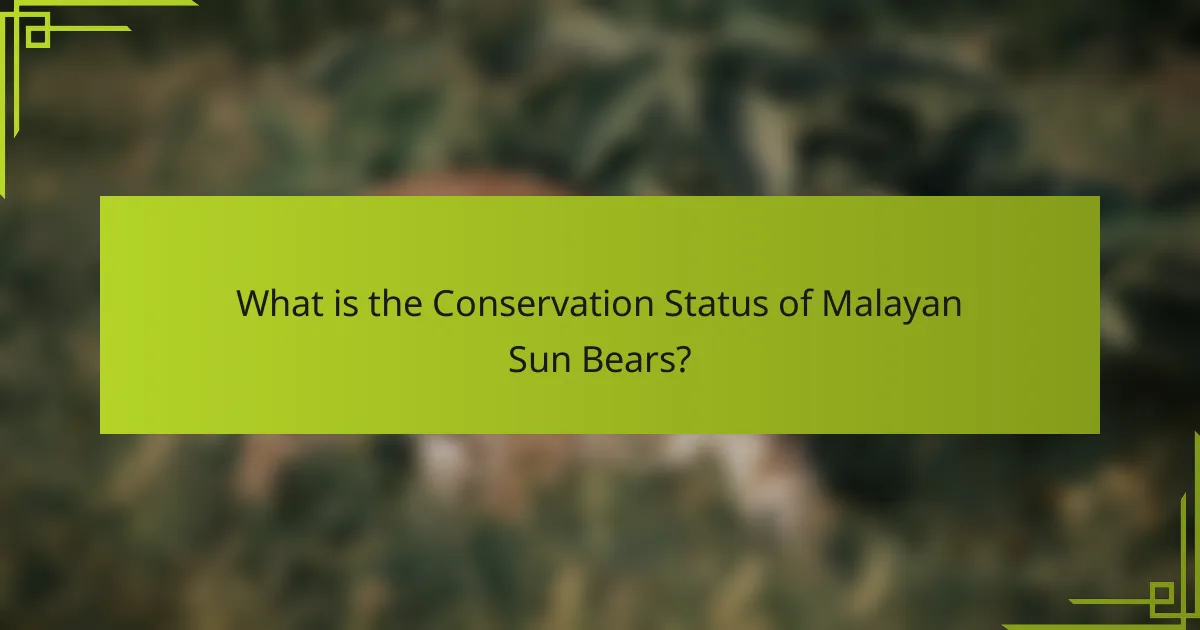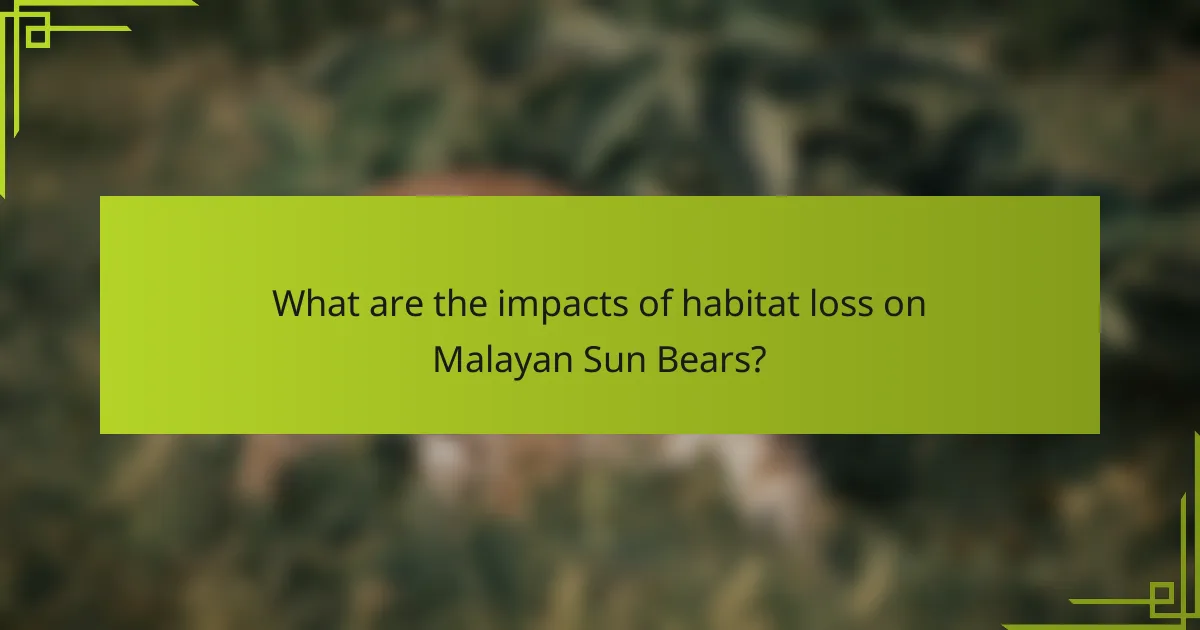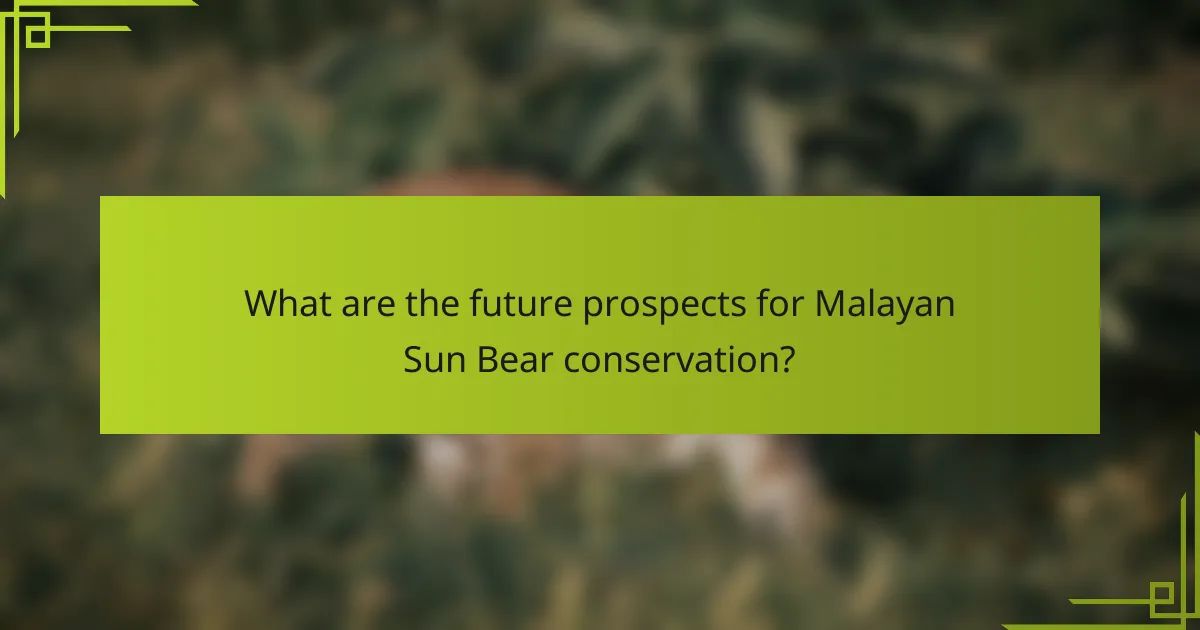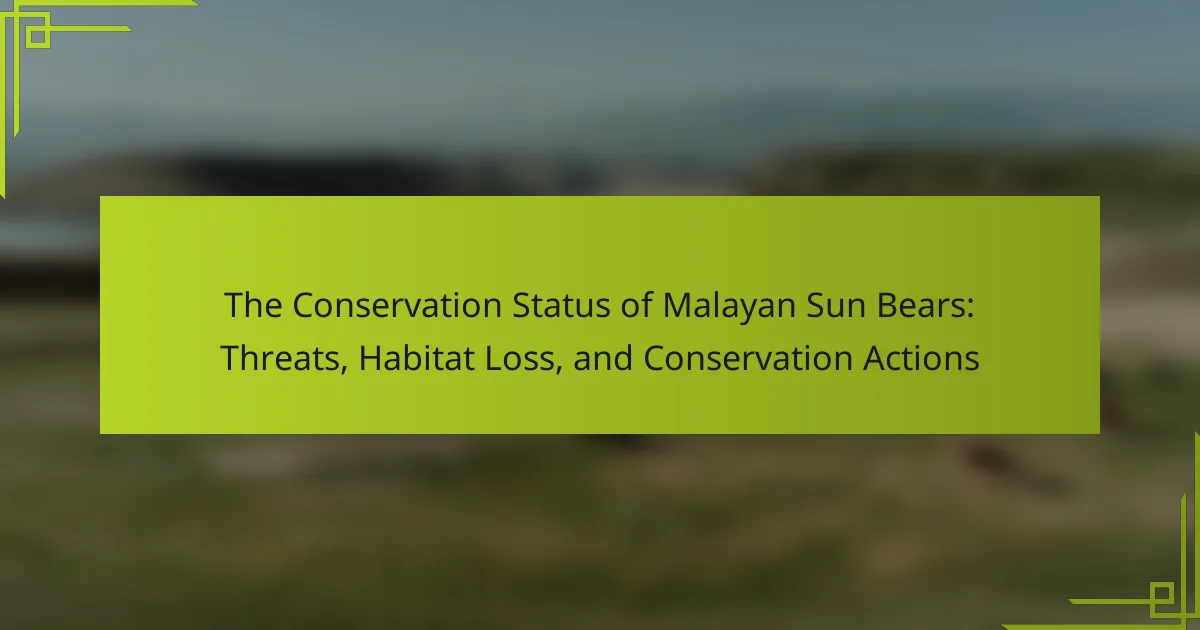Malayan sun bears, classified as Vulnerable by the International Union for Conservation of Nature (IUCN), face significant threats that increase their risk of extinction in the wild. Key issues include habitat loss from deforestation, poaching, and illegal wildlife trade, which have led to a population decline of up to 30% over the past three decades. The destruction of their natural habitat reduces food availability and isolates populations, complicating mating and increasing vulnerability to genetic decline. Current conservation efforts are focused on habitat protection, anti-poaching measures, and community awareness, aiming to enhance habitat connectivity and promote biodiversity conservation. These initiatives are essential for improving the future prospects of Malayan sun bears.

What is the Conservation Status of Malayan Sun Bears?
The conservation status of Malayan sun bears is classified as Vulnerable by the International Union for Conservation of Nature (IUCN). This classification indicates that the species faces a high risk of extinction in the wild. Key threats contributing to their vulnerable status include habitat loss due to deforestation and poaching. Malayan sun bears are also affected by illegal wildlife trade. These factors have led to significant population declines in their natural habitat across Southeast Asia. Conservation efforts are underway to protect their habitats and mitigate threats.
Why is the conservation status of Malayan Sun Bears important?
The conservation status of Malayan Sun Bears is important because it reflects their risk of extinction. As a vulnerable species, their declining population indicates habitat loss and poaching threats. Protecting their status helps maintain biodiversity in Southeast Asian ecosystems. Furthermore, conservation efforts contribute to ecological balance by preserving their role as seed dispersers. According to the IUCN Red List, habitat destruction has led to significant population declines. Monitoring their conservation status can guide effective management strategies. This ensures the survival of Malayan Sun Bears and the health of their habitats.
What role do Malayan Sun Bears play in their ecosystem?
Malayan Sun Bears play a crucial role as seed dispersers in their ecosystem. They consume a variety of fruits and berries, aiding in the growth of plants. Their foraging behavior helps in the regeneration of forests. Sun bears also contribute to controlling insect populations by feeding on termites and ants. This predation helps maintain ecological balance. Additionally, their activities create habitats for other species. For example, their digging can aerate the soil, promoting plant growth. Overall, Malayan Sun Bears are vital to maintaining biodiversity in their habitats.
How do Malayan Sun Bears contribute to biodiversity?
Malayan Sun Bears contribute to biodiversity by playing a crucial role in seed dispersal. They consume a variety of fruits and nuts, which aids in the propagation of plant species. Their foraging behavior helps maintain healthy forest ecosystems. By digging for insects and larvae, they also aerate the soil. This activity promotes nutrient cycling and supports plant growth. Additionally, they serve as prey for larger predators, which helps regulate the food web. Their presence indicates a healthy forest habitat, contributing to overall ecosystem health. Studies show that areas with Malayan Sun Bears have higher plant diversity. This highlights their significance in maintaining ecological balance.
What are the primary threats to Malayan Sun Bears?
The primary threats to Malayan Sun Bears include habitat loss, poaching, and illegal wildlife trade. Habitat loss occurs due to deforestation and land conversion for agriculture. This reduces their natural living space and food sources. Poaching is driven by demand for bear bile and other body parts in traditional medicine. Illegal wildlife trade targets Malayan Sun Bears for exotic pet markets. These threats have led to a significant decline in their population. Conservation efforts are essential to mitigate these risks and protect their habitat.
How does habitat loss affect Malayan Sun Bear populations?
Habitat loss significantly reduces Malayan Sun Bear populations. Deforestation and land conversion for agriculture diminish their natural habitats. This leads to decreased food availability, as these bears rely on fruits, insects, and small animals found in forests. Fragmented habitats isolate populations, hindering genetic diversity and reproduction. Studies indicate that habitat loss has contributed to population declines of up to 30% in some regions. Additionally, increased human-bear conflicts arise as bears venture into human settlements in search of food. Conservation efforts are essential to mitigate these impacts and restore habitats for Malayan Sun Bears.
What role does poaching play in the decline of Malayan Sun Bears?
Poaching significantly contributes to the decline of Malayan Sun Bears. It targets these bears for their body parts, which are used in traditional medicine and for illegal wildlife trade. This illegal activity reduces their population numbers and disrupts their natural behaviors. According to the International Union for Conservation of Nature (IUCN), poaching is one of the primary threats to their survival. The Malayan Sun Bear population has been decreasing due to this relentless hunting pressure. Reports indicate that poaching can lead to local extinctions in certain areas. Conservation efforts are hindered as poaching continues to be a critical issue. Thus, poaching plays a vital role in the overall decline of Malayan Sun Bears.
What conservation actions are being taken for Malayan Sun Bears?
Conservation actions for Malayan Sun Bears include habitat protection, anti-poaching efforts, and rehabilitation programs. Organizations are establishing protected areas to safeguard their natural habitats. Anti-poaching initiatives involve patrolling and enforcing laws against illegal hunting. Rehabilitation programs focus on rescuing and rehabilitating sun bears that have been orphaned or injured. Additionally, education and awareness campaigns aim to inform local communities about the importance of sun bears in the ecosystem. Research efforts are also being conducted to better understand their behavior and needs. These actions are crucial for the survival of Malayan Sun Bears in the wild.
How do protected areas benefit Malayan Sun Bear conservation?
Protected areas benefit Malayan Sun Bear conservation by providing essential habitats and reducing human-wildlife conflict. These areas safeguard the natural environment that supports the bears’ food sources, such as fruits and insects. Protected regions limit deforestation and habitat fragmentation, which are major threats to the species. According to the International Union for Conservation of Nature, establishing protected areas has been shown to improve wildlife populations. Furthermore, these areas facilitate research and monitoring of Malayan Sun Bears, enhancing conservation strategies. In Malaysia, protected areas have been linked to increased bear sightings and healthier populations. Thus, protected areas play a crucial role in the survival of Malayan Sun Bears.
What role do local communities play in conservation efforts?
Local communities play a crucial role in conservation efforts by actively participating in habitat protection and wildlife management. They often possess traditional knowledge about local ecosystems. This knowledge can guide effective conservation strategies. Community involvement leads to increased awareness of conservation issues. Engaging local populations fosters a sense of ownership over natural resources. Programs that include local communities often result in better conservation outcomes. For instance, studies show that community-managed areas can yield higher biodiversity levels. Collaboration between conservation organizations and local communities enhances resource stewardship.

What are the impacts of habitat loss on Malayan Sun Bears?
Habitat loss significantly impacts Malayan Sun Bears by reducing their natural living space. This loss leads to decreased food availability, as their primary diet consists of fruits, insects, and small vertebrates found in forests. With fewer resources, Malayan Sun Bears face increased competition for food.
Additionally, habitat fragmentation isolates bear populations, making it difficult for them to find mates. Isolated populations are more vulnerable to genetic decline and extinction. Studies indicate that habitat destruction, primarily due to logging and agriculture, has resulted in a population decline of up to 30% over the last three decades.
Furthermore, as their habitat diminishes, Malayan Sun Bears may venture into human settlements in search of food, leading to conflicts. These conflicts can result in negative consequences for both bears and humans, including injury or death of bears and property damage. Overall, habitat loss poses a critical threat to the survival of Malayan Sun Bears.
How does deforestation specifically impact Malayan Sun Bears?
Deforestation significantly impacts Malayan Sun Bears by reducing their natural habitat. These bears rely on dense forests for food and shelter. The loss of trees diminishes their access to fruits, insects, and small animals. Additionally, habitat fragmentation isolates bear populations. This isolation limits genetic diversity and increases inbreeding risks. Deforestation also exposes bears to human-wildlife conflict. As forests are cleared, bears may venture into agricultural areas, leading to negative interactions with humans. Studies indicate that habitat loss is a primary threat to their survival. The IUCN Red List classifies Malayan Sun Bears as vulnerable due to these ongoing threats.
What are the consequences of reduced food sources for Malayan Sun Bears?
Reduced food sources for Malayan Sun Bears lead to malnutrition and starvation. These bears primarily rely on fruits, insects, and small animals for sustenance. A decline in food availability directly affects their health and reproductive success. Malayan Sun Bears may experience lower birth rates due to insufficient nutrition. Additionally, reduced food sources can drive bears to expand their foraging range. This behavior increases human-wildlife conflict, as bears may enter agricultural areas in search of food. Such conflicts can result in negative perceptions of bears and potential harm to both species. Habitat loss exacerbates the issue, further diminishing food resources. Overall, reduced food sources critically threaten the survival of Malayan Sun Bears.
How does habitat fragmentation affect Malayan Sun Bear behavior?
Habitat fragmentation negatively impacts Malayan Sun Bear behavior by disrupting their movement and access to resources. This fragmentation leads to isolation of populations, which affects genetic diversity. Malayan Sun Bears require large territories for foraging and mating. When habitats are divided, their ability to find food and mates decreases. Research shows that fragmented habitats can lead to increased stress levels in these bears. Stress can alter their feeding patterns and reproductive success. Additionally, fragmented landscapes may expose bears to more human interactions, increasing the risk of conflict. Overall, habitat fragmentation significantly challenges the survival and behavioral patterns of Malayan Sun Bears.
What are the effects of climate change on Malayan Sun Bears?
Climate change negatively impacts Malayan Sun Bears. It alters their habitat and food availability. Rising temperatures can lead to habitat degradation. Deforestation and increased droughts reduce the bears’ forest environments. This loss of habitat affects their foraging behavior. Malayan Sun Bears rely on fruit and insects, which may become scarce. Changes in rainfall patterns can disrupt their food sources. As a result, their survival and reproduction rates may decline.
How does changing weather affect the habitats of Malayan Sun Bears?
Changing weather significantly impacts the habitats of Malayan Sun Bears. Fluctuations in temperature and precipitation can alter food availability. Malayan Sun Bears primarily feed on fruits, insects, and honey. Changes in weather patterns can affect the growth cycles of these food sources. For instance, increased rainfall can lead to flooding, disrupting their foraging areas. Conversely, prolonged dry spells can reduce the abundance of fruits. Habitat degradation due to climate change can also lead to fragmentation. This fragmentation limits the bears’ movement and access to resources. Ultimately, changing weather poses a threat to their survival and conservation.
What adaptations do Malayan Sun Bears need to survive climate change?
Malayan Sun Bears need behavioral and physiological adaptations to survive climate change. They may shift their foraging habits to seek food sources that are more resilient to climate fluctuations. This includes targeting fruits and insects that thrive in altered conditions. Additionally, they might alter their activity patterns to avoid extreme temperatures. Physiologically, they may develop thicker fur or enhanced fat storage to cope with temperature changes. These adaptations are crucial as climate change impacts their rainforest habitat, affecting food availability and shelter. Studies indicate that species with flexible behaviors are more likely to survive environmental changes.

What are the future prospects for Malayan Sun Bear conservation?
The future prospects for Malayan Sun Bear conservation are cautiously optimistic. Current conservation efforts focus on habitat protection and anti-poaching measures. Organizations are collaborating with local communities to raise awareness about the species. Research indicates that protected areas can support viable populations. The establishment of wildlife corridors enhances their habitat connectivity. Additionally, government policies are increasingly prioritizing biodiversity conservation. Education programs are fostering community involvement in conservation. Overall, sustained efforts and collaboration are key to improving the future for Malayan Sun Bears.
How can individuals contribute to Malayan Sun Bear conservation?
Individuals can contribute to Malayan Sun Bear conservation by supporting wildlife organizations focused on their protection. Donations to these organizations help fund habitat preservation and rescue efforts. Volunteering time can also assist in conservation projects and education programs. Raising awareness through social media can inform others about the plight of Malayan Sun Bears. Reducing palm oil consumption helps combat habitat loss, as palm oil plantations threaten their living spaces. Participating in local clean-up events protects their habitats from pollution. Lastly, advocating for stronger wildlife protection laws can influence policy changes that benefit Malayan Sun Bears.
What actions can be taken at the community level?
Community-level actions for the conservation of Malayan sun bears include habitat restoration, awareness campaigns, and community monitoring programs. Habitat restoration involves replanting native vegetation to recover degraded areas. Awareness campaigns educate locals about the importance of sun bears and their role in the ecosystem. Community monitoring programs engage residents in tracking bear populations and reporting illegal activities. These actions empower communities to take ownership of conservation efforts. Engaging local stakeholders increases the effectiveness of conservation strategies. Studies show that community involvement leads to better outcomes in wildlife conservation.
How can awareness and education promote conservation efforts?
Awareness and education can significantly promote conservation efforts by informing the public about the importance of biodiversity. Educated individuals are more likely to engage in conservation activities. Awareness campaigns can highlight the threats faced by species such as the Malayan sun bear. Research shows that knowledge about habitat loss leads to increased support for conservation policies. Educational programs can foster a sense of responsibility towards wildlife. Community involvement in conservation initiatives often stems from increased awareness. Studies indicate that informed communities are more effective in protecting local ecosystems. Overall, education empowers individuals to make informed decisions that benefit conservation.
What best practices should be followed for Malayan Sun Bear conservation?
Best practices for Malayan Sun Bear conservation include habitat protection, anti-poaching measures, and community engagement. Protecting their natural habitat is crucial as deforestation significantly threatens their survival. Implementing strict anti-poaching laws helps reduce illegal hunting, which is a major threat to their population. Engaging local communities in conservation efforts fosters awareness and support for sun bear protection. Education programs about the ecological role of sun bears can enhance community involvement. Establishing wildlife corridors promotes genetic diversity by connecting fragmented habitats. Collaborating with conservation organizations can provide additional resources and expertise. Monitoring bear populations through research helps assess the effectiveness of conservation strategies.
What are the key strategies for effective habitat restoration?
Key strategies for effective habitat restoration include assessing the current state of the habitat, setting clear restoration goals, and involving local communities. Assessing the habitat helps identify specific degradation issues. Setting clear goals ensures focused efforts on desired outcomes. Engaging local communities fosters support and sustainable practices. Additionally, using native plant species promotes ecological balance. Monitoring progress allows for adjustments in strategy as needed. Restoration efforts should also consider wildlife needs to ensure biodiversity. Collaborating with experts enhances the effectiveness of restoration initiatives.
How can policies be improved to enhance Malayan Sun Bear protection?
Policies can be improved to enhance Malayan Sun Bear protection by implementing stricter wildlife trafficking laws. Effective enforcement of these laws can reduce illegal hunting and trade. Establishing protected areas specifically for Malayan Sun Bears can safeguard their natural habitats. Increasing funding for conservation programs will support research and habitat restoration efforts. Engaging local communities in conservation initiatives fosters stewardship and awareness. Educational campaigns can inform the public about the ecological importance of Malayan Sun Bears. Collaborating with international organizations can strengthen global conservation efforts. These measures collectively contribute to a more robust protection framework for Malayan Sun Bears.
The main entity of this article is the Malayan Sun Bear, classified as Vulnerable by the International Union for Conservation of Nature (IUCN). The article outlines the key threats to this species, including habitat loss from deforestation, poaching, and illegal wildlife trade, which significantly impact their population and ecological role. It discusses the importance of conservation efforts such as habitat protection, anti-poaching initiatives, and community involvement in safeguarding their future. Additionally, the article highlights the consequences of climate change on their habitats and food sources, emphasizing the need for effective policies and community engagement to enhance protection for Malayan Sun Bears.
